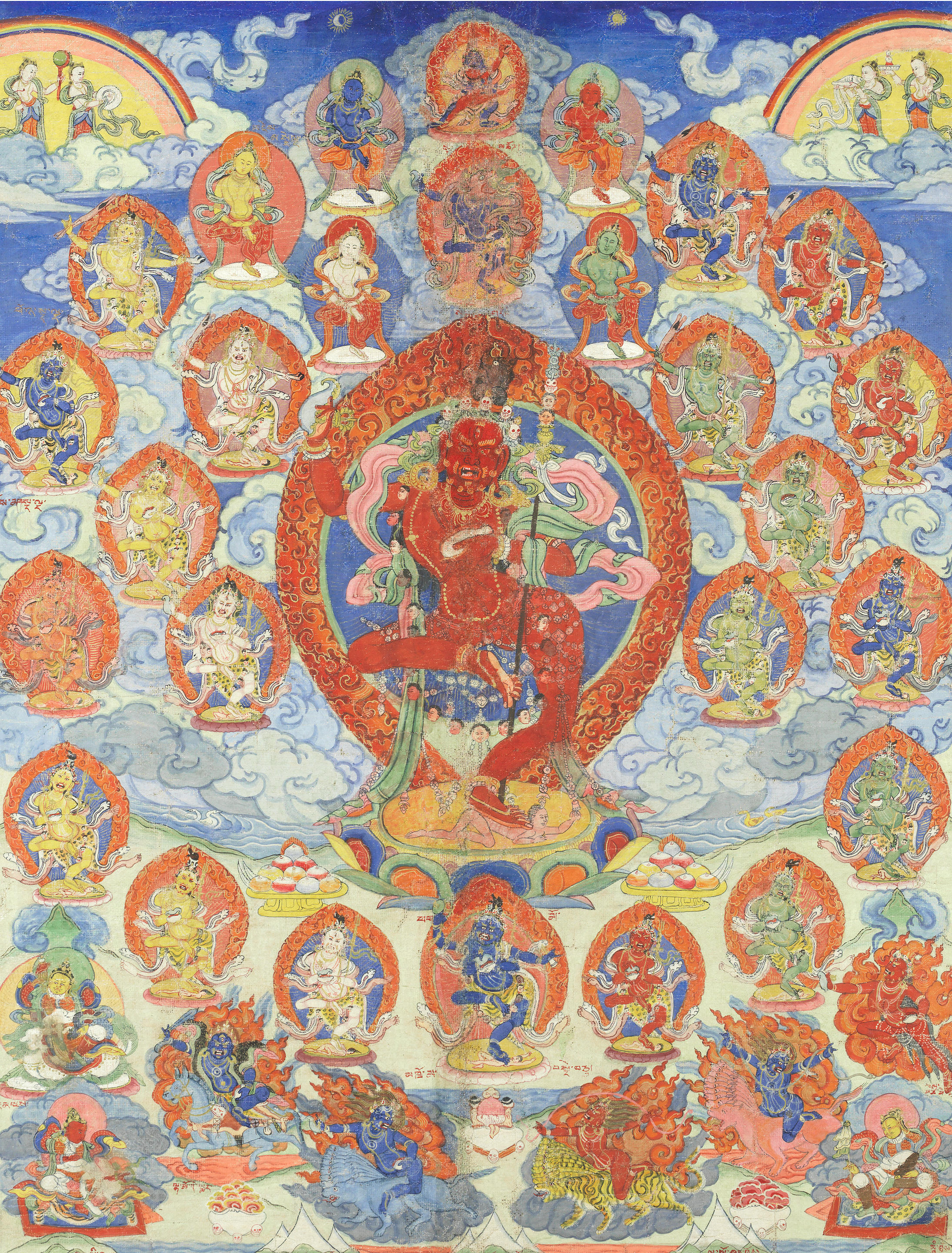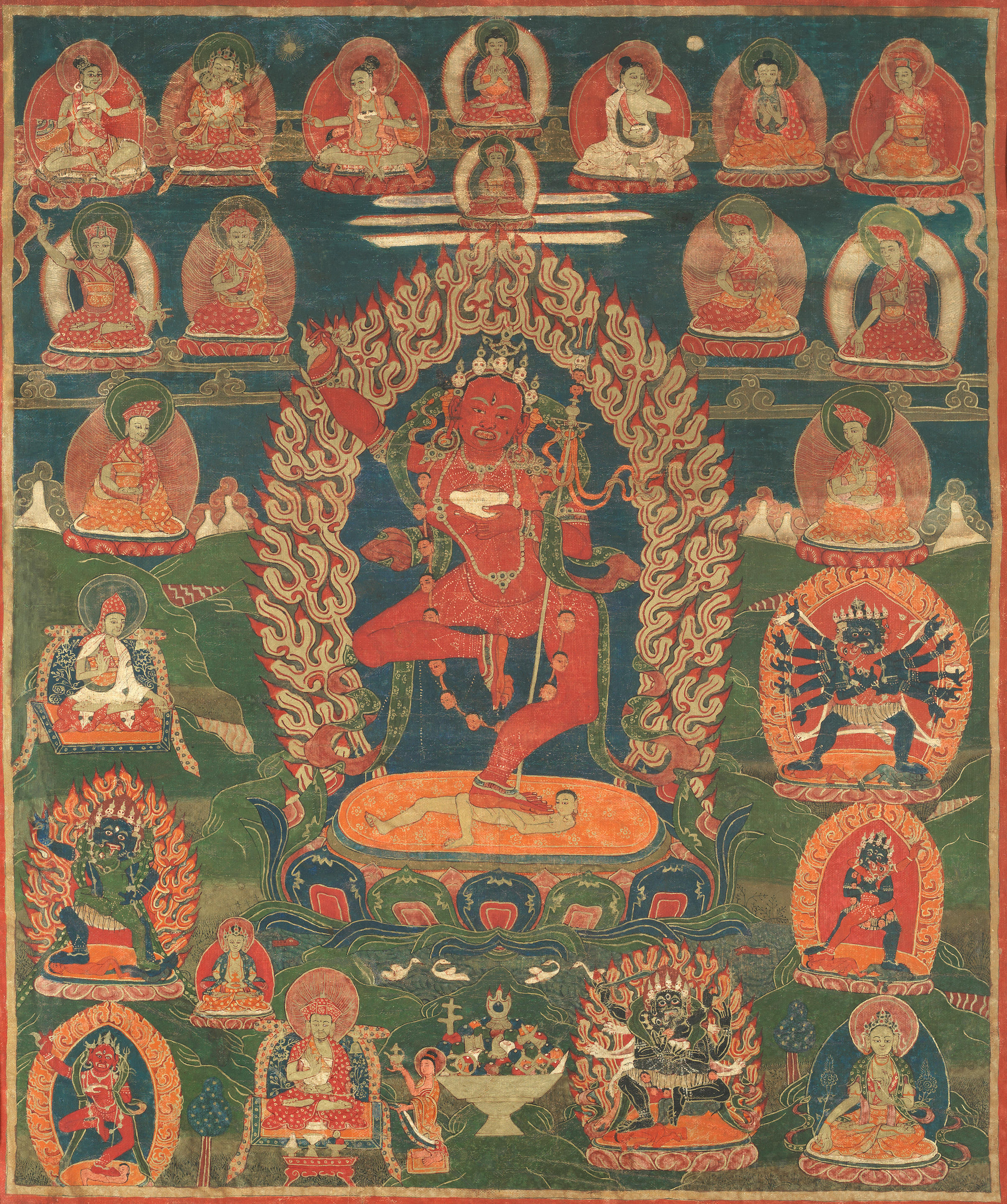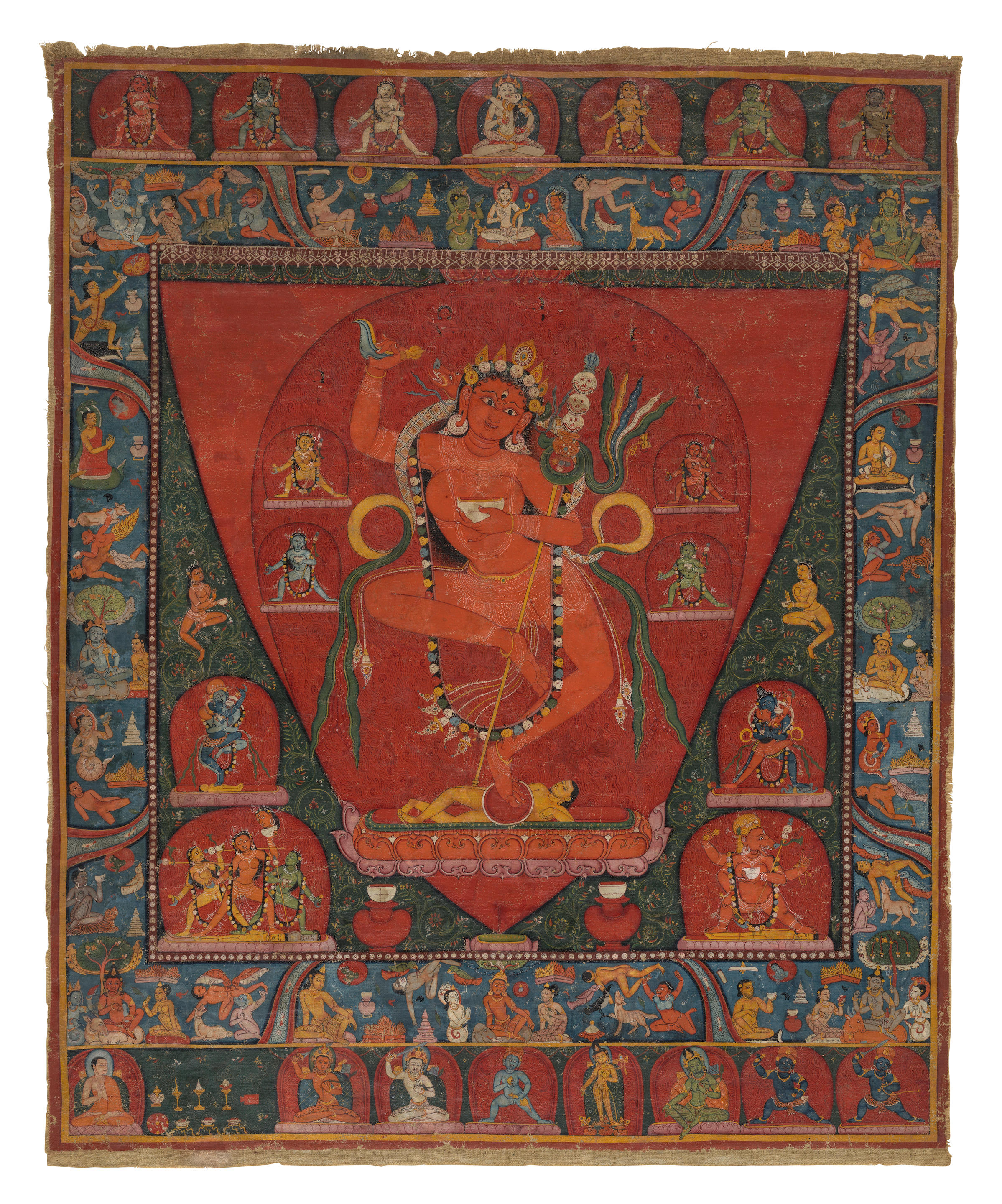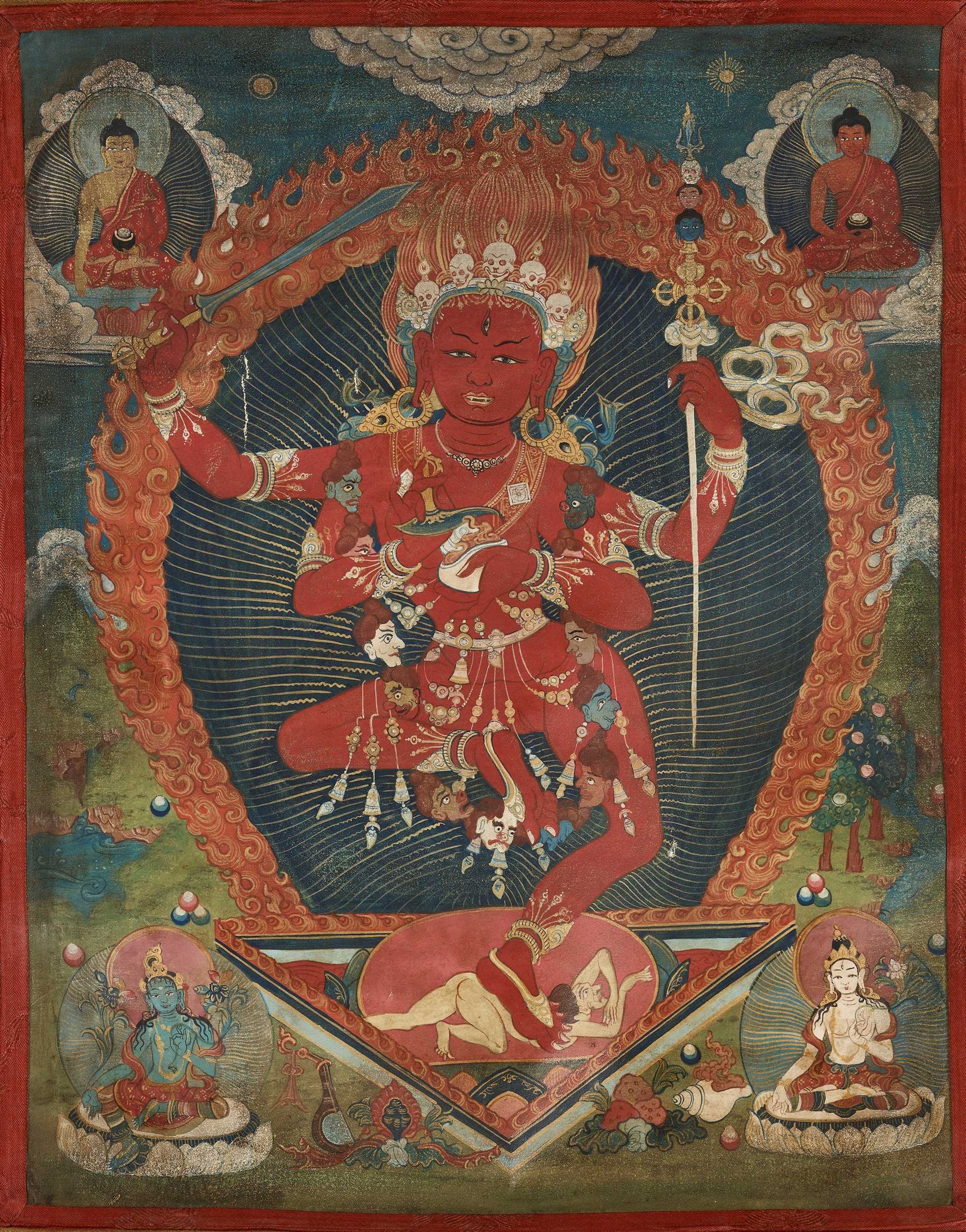A THANGKA OF VAJRAVARAHITIBET, CIRCA 12TH CENTURY Distemper on cloth; verso with the Buddhist creed "y'e-dha-rma-he-du-pra..." in ink. Himalayan Art Resources item no. 4735 79.5 x 59.5 cm (31 x 23 1/2 in.)Footnotes西藏 約十二世紀 金剛亥母唐卡 Vajravarahi, the red tantric goddess, is depicted here dancing in a formal arrangement of shallow space. Bodhisattvas and wrathful protectors painted with exquisite delineations flank the side registers. A retinue of dakinis line the bottom, each depicted in a different color, as a single donor figure in white robes sits in the lower left corner. In the top register, Indian and Tibetan Buddhist masters are illustrated, each with distinctive character, costume, coiffure, and facial features. Indian mahasiddhas are depicted with bare torsos, Indian monks in full red robes, and Tibetan monks wear brimmed yellow caps and blue or white inner robes covered by red, saffron, or white outer robes. The figure near the top right corner, clad in a yellow sleeveless vest, red inner robe, and yellow outer robe has the common sartorial appearence of a Taklung master, whose order flourished during the 12th and 13th centuries. The thangka's geometric layout featuring the goddess as the prominent central figure, the pronounced coloration of red and orange pigments, and her naked appearance adorned with white bone jewelry and accompanying ensemble correspond with other 12th-/13th-century depictions of the goddess, particularly one illustrated in Kossak and Singer, Sacred Visions, 1998, pp. 100-1. Similarities between the paintings are unmistakable. In both, the dakini is painted vermillion and set within a darker red flame background. She holds the implements of a skull cup, hooked knife, and ritual staff. Each wears a garland of severed skulls, and both hold a fluttering green tipped scarf around their necks. The posture is identical with the right knee crossed horizontally against her body as her left leg tramples a sun disc over a supine figure on an ochre base. Encircling her in each are smaller dancing dakinis on floating bases which are further surrounded by eight cremation grounds painted on a dark blue background with each vignette separated by a winding stream. Despite these similarities, these images when closely compared are not mere imitations of one another. The face of the present central goddess is narrow with features delineated with a thick black contouring line, closely linked in style to a particular Vajravarahi mandala (ibid, pp. 96-9). She wears thick cuffed bracelets at the wrists, heavy earrings in the shape of cylindrical drums, and a festooned necklace along her collar, following a closer parallel again to the mandala. The overall format is less wide than the Kossak Vajravarahi, making the definitions of each figure more pronounced, though the principal position of the goddess at center is pronounced in both. Like the Indic models from which these features of format derive, dimensionally larger figures show rank rather than illustrating perspectives in space. Tibetans employed this arrangement to reinforce hierarchy and lineage sequencing, as seen here, and while each of these images is surrounded by various other deities and lineage figures, in the case of each of these thangkas, those figures differ. As Tibetan thangkas of this formative period typically reveal, iconography is mostly prescribed and formulaic in nature. In the tantric cosmos depicted here, there is value in appreciating the continuity of form. In effect, this mode of repetition serves to emblemize religious rites in visual forms. The hierarchy of the main figure held in tandem with lineage figures and deities playing supporting roles in the surrounding registers is laid out in an ordered, readable scheme highlighting the sow-headed wrathful deity who dances in flames. Yet, the syntax of the painting, as straightforward as it seems, ultimately is meant to inform an esoteric practice aimed at triumphing over ignorance. Published:
A THANGKA OF VAJRAVARAHITIBET, CIRCA 12TH CENTURY Distemper on cloth; verso with the Buddhist creed "y'e-dha-rma-he-du-pra..." in ink. Himalayan Art Resources item no. 4735 79.5 x 59.5 cm (31 x 23 1/2 in.)Footnotes西藏 約十二世紀 金剛亥母唐卡 Vajravarahi, the red tantric goddess, is depicted here dancing in a formal arrangement of shallow space. Bodhisattvas and wrathful protectors painted with exquisite delineations flank the side registers. A retinue of dakinis line the bottom, each depicted in a different color, as a single donor figure in white robes sits in the lower left corner. In the top register, Indian and Tibetan Buddhist masters are illustrated, each with distinctive character, costume, coiffure, and facial features. Indian mahasiddhas are depicted with bare torsos, Indian monks in full red robes, and Tibetan monks wear brimmed yellow caps and blue or white inner robes covered by red, saffron, or white outer robes. The figure near the top right corner, clad in a yellow sleeveless vest, red inner robe, and yellow outer robe has the common sartorial appearence of a Taklung master, whose order flourished during the 12th and 13th centuries. The thangka's geometric layout featuring the goddess as the prominent central figure, the pronounced coloration of red and orange pigments, and her naked appearance adorned with white bone jewelry and accompanying ensemble correspond with other 12th-/13th-century depictions of the goddess, particularly one illustrated in Kossak and Singer, Sacred Visions, 1998, pp. 100-1. Similarities between the paintings are unmistakable. In both, the dakini is painted vermillion and set within a darker red flame background. She holds the implements of a skull cup, hooked knife, and ritual staff. Each wears a garland of severed skulls, and both hold a fluttering green tipped scarf around their necks. The posture is identical with the right knee crossed horizontally against her body as her left leg tramples a sun disc over a supine figure on an ochre base. Encircling her in each are smaller dancing dakinis on floating bases which are further surrounded by eight cremation grounds painted on a dark blue background with each vignette separated by a winding stream. Despite these similarities, these images when closely compared are not mere imitations of one another. The face of the present central goddess is narrow with features delineated with a thick black contouring line, closely linked in style to a particular Vajravarahi mandala (ibid, pp. 96-9). She wears thick cuffed bracelets at the wrists, heavy earrings in the shape of cylindrical drums, and a festooned necklace along her collar, following a closer parallel again to the mandala. The overall format is less wide than the Kossak Vajravarahi, making the definitions of each figure more pronounced, though the principal position of the goddess at center is pronounced in both. Like the Indic models from which these features of format derive, dimensionally larger figures show rank rather than illustrating perspectives in space. Tibetans employed this arrangement to reinforce hierarchy and lineage sequencing, as seen here, and while each of these images is surrounded by various other deities and lineage figures, in the case of each of these thangkas, those figures differ. As Tibetan thangkas of this formative period typically reveal, iconography is mostly prescribed and formulaic in nature. In the tantric cosmos depicted here, there is value in appreciating the continuity of form. In effect, this mode of repetition serves to emblemize religious rites in visual forms. The hierarchy of the main figure held in tandem with lineage figures and deities playing supporting roles in the surrounding registers is laid out in an ordered, readable scheme highlighting the sow-headed wrathful deity who dances in flames. Yet, the syntax of the painting, as straightforward as it seems, ultimately is meant to inform an esoteric practice aimed at triumphing over ignorance. Published:














Try LotSearch and its premium features for 7 days - without any costs!
Be notified automatically about new items in upcoming auctions.
Create an alert